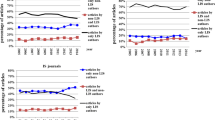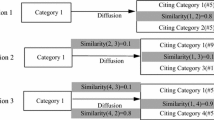Abstract
This study employs the method of direct citation to analyze and compare the interdisciplinary characteristics of the two disciplines of library science and information science during the period of 1978–2007. Based on the research generated by five library science journals and five information science journals, library science researchers tend to cite publications from library and information science (LIS), education, business/management, sociology, and psychology, while researchers of information science tend to cite more publications from LIS, general science, computer science, technology, and medicine. This means that the disciplines with larger contributions to library science are almost entirely different from those contributing to information science. In addition, researchers of library science frequently cite publications from LIS; the rate is as high as 65.61%, which is much higher than the rate for information science, 49.50%. However, a decreasing trend in the percentage of LIS in library science indicates that library science researchers tend to cite more publications from non-LIS disciplines. A rising trend in the proportion of references to education sources is reported for library science articles, while a rising trend in the proportion of references to computer science sources has been found for information science articles. In addition, this study applies an interdisciplinary indicator, Brillouin’s Index, to measurement of the degree of interdisciplinarity. The results confirm that the trend toward interdisciplinarity in both information science and library science has risen over the years, although the degree of interdisciplinarity in information science is higher than that in library science.




Similar content being viewed by others
References
Al-Sabbagh, I. A. (1987). The evolution of the interdisciplinarity of information science: A bibliometric study. (Unpublished doctoral dissertation). Florida State: Florida State University.
Åström, F. (2010). The visibility of information science and library science research in bibliometric mapping of the LIS field. Library Quarterly, 80(2), 143–159.
Buckland, M. (1999). The landscape of information science: The American Society for Information Science at 62. Journal of the American Society of Information Science, 50(11), 970–974.
Buttlar, L. (1999). Information sources in library and information science doctoral research. Library & Information Science Research, 21(2), 227–245.
Chen, K. H., & Liang, C. F. (2004). Disciplinary interflow of library and information science in Taiwan. Journal of Library and Information Studies, 2, 43–45.
Cheng, L. M. (1995). Characteristics of cited references in the journal articles of library and information science in Taiwan from 1974 to 1993. Journal of Educational Media & Library Sciences, 32(2), 210–238.
Cheung, K. F. (1990). Interdisciplinary relationships between social work and other disciplines: A citation study. Social Work Research & Abstracts, 26(3), 23–29.
Chikate, R.V., & Patil, S. K. (2008). Citation analysis of theses in library and information science submitted to University of Pune: A pilot study. Library Philosophy and Practice. http://unllib.unl.edu/LPP/chikate-patil.html. Accessed 20 December 2010.
Choi, J. M. (1988). Citation analysis of intra- and interdisciplinary communication patterns of anthropology in the U.S.A. Behavioral and Social Sciences Librarian, 6(3/4), 65–84.
Hargens, L. L. (1986). Migration patterns of U. S. Ph.D.s among disciplines and specialties. Scientometrics, 9(3/4), 145–164.
Hawkins, D. T. (2001). Information science abstracts: tracking the literature of information science. Part 1: Definition and map. Journal of the American Society for Information Science and Technology, 52(1), 44–53.
Holland, G. A. (2008). Information science: An interdisciplinary effort? Journal of Documentation, 64(1), 7–23.
Huang, M. H., & Chang, Y. W. (2011). A study of interdisciplinarity in information science: Using direct citation and co-authorship analysis. Journal of Information Science, 37(4), 369–378.
Huang, M. H., & Ho, H. P. (2009). A study of indicators for knowledge originality and knowledge generality in library & information science. Journal of Library and Information Science, 35(2), 14–33.
Hurd, J. M. (1992). Interdisciplinary research in the sciences: Implications for library organization. College & Research Libraries, 53(4), 283–297.
Huutoniemi, K., Klein, J. T., Bruun, H., & Hukkinen, J. (2010). Analyzing interdisciplinarity: Typology and indicators. Research Policy, 39, 79–88.
Janssens, F., Glanzel, W., & Moor, B. (2008). A hybrid mapping of information science. Scientometrics, 75(3), 607–631.
Järvelin, K., & Vakkari, P. (1993). The evolution of library and information science 1965–1985: A content analysis of journal articles. Information Processing & Management, 29(1), 129–144.
Khawam, Y. (1992). The contribution of library science to interdisciplinary research: The example of artificial intelligence. Documentaliste, 29(3), 129–135.
LaBorie, T., & Halperin, M. (1976). Citation patterns in library science dissertations. Journal of Education for Librarianship, 16, 271–283.
Leydesdorff, L., & Probst, C. (2009). The delineation of an interdisciplinary specialty in terms of a journal set: The case of communication studies. Journal of the American Society for Information Science and Technology, 60(8), 1709–1718.
Ma, R. M., Dai, Q. B., Ni, C. Q., & Li, X. L. (2009). An author co-citation analysis of information science in China with Chinese Google Scholar search engine, 2004–2006. Scientometrics, 81(1), 33–46.
Milojevic, S. (2010). Power law distributions in information science: Making the case for logarithmic binning. Journal of the American Society for Information Science and Technology, 61(12), 2415–2417.
Pair, C. L. (1980). Switching between academic disciplines in universities in the Netherlands. Scientometrics, 2(3), 177–191.
Palmer, C. L., & Neumann, L. J. (2002). The information work of interdisciplinary humanities scholars: Exploration and translation. Library Quarterly, 72(1), 85–117.
Peters, H. P. F., & Van Raan, A. F. J. (1994). A bibliometric profile of top-scientists: A case study in chemical engineering. Scientometrics, 29(1), 115–136.
Pluzhenskaya, M. (2008). LIS and other knowledge domains: Interdisciplinarity of LIS scholars’ publications (polite study). Proceedings of the 36th annual conference of the Canadian Association for Information Science (CAIS), University of British Columbia, Vancouver, June 5-7, 2008. http://www.cais-acsi.ca/proceedings/2008/pluzhenskaya_2008.pdf. Accessed June 6, 2010.
Porter, A. L., & Chubin, D. E. (1985). An indicator of cross-disciplinary research. Scientometrics, 8(3/4), 161–176.
Rinia, E. J., Leeuwen, T. N. V., Bruins, E. E. W., Vuren, H. G. V., & Van Raan, A. F. J. (2002). Measuring knowledge transfer between fields of science. Scientometrics, 54(3), 347–362.
Robinson, L., & Karamaftuoglu, M. (2010). The nature of information science: Changing models. Information Research, 15(4). http://informationr.net/ir/15-4/colis717.html. Accessed 10 June 2011.
Rosenfield, P. L. (1992). The potential of transdisciplinary research for sustaining and extending linkages between the health and social sciences. Social Science and Medicine, 35(11), 1343–1357.
Sanz-Casado, E., Martin-Moreno, C., Garcia-Zorita, C., & Lascurain-Sanchez, M. L. (2004). Study of interdisciplinarity in chemistry research based on the production of Puerto Rican scientists 1992–2001. Information Research, 9(4). http://informationr.net/ir/9-4/paper182.html. Accessed 11 August 2009.
Saracevic, T. (1992). Information science: Origin, evolution and relations. Proceedings of the International Conference Conceptions of Library and Information Science Historical Empirical and Theoretical Perspective University of Tampere Finland 2628 August 1991 (pp. 5–27). Taylor Graham. http://www.scils.rutgers.edu/~kantor/601/Readings2004/Week2/w2R1.PDF. Accessed 1 June 2011.
Shi, M. Y. (2002). The study of library science in Taiwan analyzed by journal articles. Taipei: Han-Mei.
Song, C. H. (2003). Interdisciplinarity and knowledge inflow/outflow structure among science and engineering research in Korea. Scientometrics, 58(1), 129–141.
Steele, T. W., & Stier, J. C. (2000). The impact of interdisciplinary research in the environmental sciences: A forestry case study. Journal of the American Society for Information Science, 51(5), 476–484.
Tang, R. (2004). Evolution of the interdisciplinary characteristics of information and library science. Proceedings of the American Society for Information Science and Technology, 41(1), 54–63.
Tijssen, R. J. W. (1992). A quantitative assessment of interdisciplinary structures in science and technology: Co-classification analysis of energy research. Research Policy, 21(1), 27–34.
Trajtenberg, M., Henderson, R., & Jaffe, A. (1997). University versus corporate patents: A window on the basicness of invention. Economic of Innovation and New Technology, 5(1), 19–50.
Tsay, M. Y. (2008). Journal bibliometric analysis: A case study on the JASIST. Malaysian Journal of Library & Information Science, 13(2), 121–139.
White, H. D., & Griffith, B. C. (1981). Author cocitation: A literature measure of intellectual structure. Journal of the American Society for Information Science, 32(3), 163–171.
White, H. D., & McCain, K. W. (1998). Visualizing a discipline: An author co-citation analysis of information science, 1972–1995. Journal of the American Society for Information Science, 49(4), 327–355.
Zins, C. (2007). Classification schemes of information science: Twenty-eight scholars map the filed. Journal of the American Society for Information Science and Technology, 58(5), 645–672.
Author information
Authors and Affiliations
Corresponding author
Appendix
Rights and permissions
About this article
Cite this article
Huang, MH., Chang, YW. A comparative study of interdisciplinary changes between information science and library science. Scientometrics 91, 789–803 (2012). https://doi.org/10.1007/s11192-012-0619-7
Received:
Published:
Issue Date:
DOI: https://doi.org/10.1007/s11192-012-0619-7




